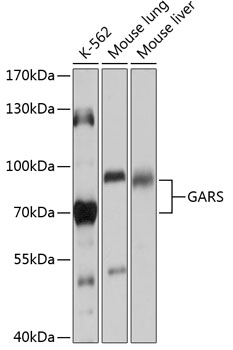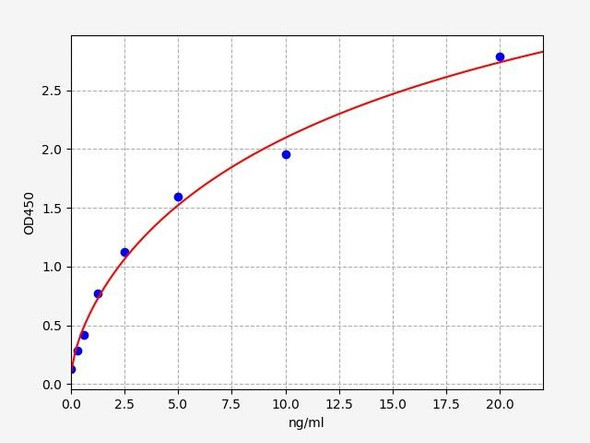Anti-GARS Antibody (CAB13305)
- SKU:
- CAB13305
- Product type:
- Antibody
- Reactivity:
- Human
- Mouse
- Host Species:
- Rabbit
- Isotype:
- IgG
- Antibody Type:
- Polyclonal Antibody
- Research Area:
- Metabolism
Frequently bought together:
Description
| Antibody Name: | Anti-GARS Antibody |
| Antibody SKU: | CAB13305 |
| Antibody Size: | 20uL, 50uL, 100uL |
| Application: | WB IF |
| Reactivity: | Human, Mouse |
| Host Species: | Rabbit |
| Immunogen: | Recombinant fusion protein containing a sequence corresponding to amino acids 60-370 of human GARS (NP_002038.2). |
| Application: | WB IF |
| Recommended Dilution: | WB 1:500 - 1:2000 IF 1:50 - 1:200 |
| Reactivity: | Human, Mouse |
| Positive Samples: | K-562, Mouse lung, Mouse liver |
| Immunogen: | Recombinant fusion protein containing a sequence corresponding to amino acids 60-370 of human GARS (NP_002038.2). |
| Purification Method: | Affinity purification |
| Storage Buffer: | Store at -20°C. Avoid freeze / thaw cycles. Buffer: PBS with 0.02% sodium azide, 50% glycerol, pH7.3. |
| Isotype: | IgG |
| Sequence: | AEEV LAPL RLAV RQQG DLVR KLKE DKAP QVDV DKAV AELK ARKR VLEA KELA LQPK DDIV DRAK MEDT LKRR FFYD QAFA IYGG VSGL YDFG PVGC ALKN NIIQ TWRQ HFIQ EEQI LEID CTML TPEP VLKT SGHV DKFA DFMV KDVK NGEC FRAD HLLK AHLQ KLMS DKKC SVEK KSEM ESVL AQLD NYGQ QELA DLFV NYNV KSPI TGND LSPP VSFN LMFK TFIG PGGN MPGY LRPE TAQG IFLN FKRL LEFN QGKL PFAA AQIG NSFR NEIS PRSG LIRV REFT MAEI EHFV DPSE KDHP KFQN VAD |
| Gene ID: | 2617 |
| Uniprot: | P41250 |
| Cellular Location: | Cell projection, Cytoplasm, Mitochondrion, axon |
| Calculated MW: | 83kDa |
| Observed MW: | 70-83kDa |
| Synonyms: | GARS, CMT2D, DSMAV, GlyRS, HMN5, SMAD1 |
| Background: | This gene encodes glycyl-tRNA synthetase, one of the aminoacyl-tRNA synthetases that charge tRNAs with their cognate amino acids. The encoded enzyme is an (alpha)2 dimer which belongs to the class II family of tRNA synthetases. It has been shown to be a target of autoantibodies in the human autoimmune diseases, polymyositis or dermatomyositis. Two transcript variants encoding different isoforms have been found for this gene. |
| UniProt Protein Function: | GARS: Catalyzes the attachment of glycine to tRNA(Gly). Is also able produce diadenosine tetraphosphate (Ap4A), a universal pleiotropic signaling molecule needed for cell regulation pathways, by direct condensation of 2 ATPs. Defects in GARS are the cause of Charcot-Marie-Tooth disease type 2D (CMT2D). CMT2D is a form of Charcot- Marie-Tooth disease, the most common inherited disorder of the peripheral nervous system. Charcot-Marie-Tooth disease is classified in two main groups on the basis of electrophysiologic properties and histopathology: primary peripheral demyelinating neuropathy or CMT1, and primary peripheral axonal neuropathy or CMT2. Neuropathies of the CMT2 group are characterized by signs of axonal regeneration in the absence of obvious myelin alterations, normal or slightly reduced nerve conduction velocities, and progressive distal muscle weakness and atrophy. CMT2D is characterized by a more severe phenotype in the upper extremities (severe weakness and atrophy, absence of tendon reflexes) than in the lower limbs. CMT2D inheritance is autosomal dominant. Defects in GARS are a cause of distal hereditary motor neuronopathy type 5A (HMN5A); also known as distal hereditary motor neuropathy type V (DSMAV). A disorder characterized by distal muscular atrophy mainly affecting the upper extremities, in contrast to other distal motor neuronopathies. These constitute a heterogeneous group of neuromuscular diseases caused by selective degeneration of motor neurons in the anterior horn of the spinal cord, without sensory deficit in the posterior horn. The overall clinical picture consists of a classical distal muscular atrophy syndrome in the legs without clinical sensory loss. The disease starts with weakness and wasting of distal muscles of the anterior tibial and peroneal compartments of the legs. Later on, weakness and atrophy may expand to the proximal muscles of the lower limbs and/or to the distal upper limbs. Belongs to the class-II aminoacyl-tRNA synthetase family. |
| UniProt Protein Details: | Protein type:Mitochondrial; EC 6.1.1.14; Ligase; Translation Chromosomal Location of Human Ortholog: 7p15 Cellular Component: nucleoplasm; mitochondrial matrix; cytoplasm; cytosol; secretory granule Molecular Function:protein dimerization activity; glycine-tRNA ligase activity; ATP binding Biological Process: tRNA aminoacylation for protein translation; glycyl-tRNA aminoacylation; gene expression; diadenosine tetraphosphate biosynthetic process Disease: Neuronopathy, Distal Hereditary Motor, Type Va; Charcot-marie-tooth Disease, Axonal, Type 2d |
| NCBI Summary: | This gene encodes glycyl-tRNA synthetase, one of the aminoacyl-tRNA synthetases that charge tRNAs with their cognate amino acids. The encoded enzyme is an (alpha)2 dimer which belongs to the class II family of tRNA synthetases. It has been shown to be a target of autoantibodies in the human autoimmune diseases, polymyositis or dermatomyositis. [provided by RefSeq, Jul 2008] |
| UniProt Code: | P41250 |
| NCBI GenInfo Identifier: | 313104283 |
| NCBI Gene ID: | 2617 |
| NCBI Accession: | P41250.3 |
| UniProt Secondary Accession: | P41250,Q969Y1, B3KQA2, B4DIA0, |
| UniProt Related Accession: | P41250 |
| Molecular Weight: | 739 |
| NCBI Full Name: | Glycine--tRNA ligase |
| NCBI Synonym Full Names: | glycyl-tRNA synthetase |
| NCBI Official Symbol: | GARS |
| NCBI Official Synonym Symbols: | HMN5; CMT2D; DSMAV; GlyRS; SMAD1 |
| NCBI Protein Information: | glycine--tRNA ligase; AP-4-A synthetase; glycine tRNA ligase; Charcot-Marie-Tooth neuropathy 2D; diadenosine tetraphosphate synthetase; Charcot-Marie-Tooth neuropathy, neuronal type, D |
| UniProt Protein Name: | Glycine--tRNA ligase |
| UniProt Synonym Protein Names: | Diadenosine tetraphosphate synthetase; AP-4-A synthetase; Glycyl-tRNA synthetase; GlyRS |
| Protein Family: | Glycine--tRNA ligase |
| UniProt Gene Name: | GARS |
| UniProt Entry Name: | SYG_HUMAN |









